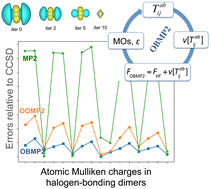Can second-order perturbation theory accurately predict electron density of open-shell molecules? The importance of self-consistency
Abstract
Electron density plays an essential role in predicting molecular properties. It is also a simple observable from which machine-learning models for molecular electronic structure can be derived. In this work, we present the performance of the one-body Møller–Plesset second-order perturbation (OBMP2) theory, which we have recently developed, in predicting electron density and related properties. In OBMP2, an effective one-body Hamiltonian including dynamic correlation at the MP2 level is derived using the canonical transformation followed by the cumulant approximation. We diagonalize the effective one-body Hamiltonian to yield eigenvalues and eigenvectors corresponding to molecular orbitals and orbital energies that are then used to update the MP2 double-excitation amplitudes. We examine the OBMP2 performance by considering three different groups of open-shell systems: atomic systems, main-group radicals, and halogen-bonding dimers. We find that OBMP2 outperforms standard MP2 and density functional theory in all cases considered here, and its accuracy is comparable to coupled-cluster singles and doubles (CCSD), a higher-level method. OBMP2 is thus believed to be an effective method for predicting the accurate electron density of open-shell molecules.



 Please wait while we load your content...
Please wait while we load your content...